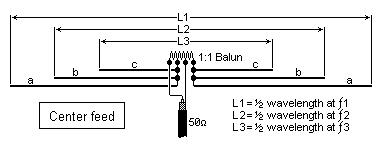

The DIPOLE antenna is perhaps the simplest and easiest antenna to erect, but I have still seen installations where basic mistakes have been made. So here is some reference data, pointers and ideas that may help you.
To me, QRP means transmitting and establishing contact with other stations using a reasonable amount of power. With typically less than ten watts available it is vitally important to ensure that the antenna system is not wasting energy. Firstly, the antenna must be cut to the right length and matched to the transmitter.

The balun shown above is required to match the ballanced antenna to an unballanced feeder. Typicaly 5 + 5 + 5 turns of thick enamelled wire are wound on a ferrite ring, the three coils are connected in series from the start of one winding to the end of the next. L1, L2 and L3 are for resonance on three different bands. L1 (a+a), L2 (b+b) and L3 (c+c) are equal to:

Add as many dipoles as you need to form an antenna system for the bands you want. Naturally, there will be a limit, but this is a practical limit. You can reduce the amount of wire you need for a multiband antenna by using an "off-center" feed point and using a 4:1 balun:

The bands must be twice the frequency of the previous band with this method. For example, if a=60 meters and b=30 meters, then a+b will resonate at about 1.8 MHz. If c=15 meters then b+c will resonate at 3.5MHz. If d=7 meters, then c+d will resonate at about 7 MHz. This technique can reduce the amount of wire you have to buy.
You can reduce the physical length of a dipole by inserting a coil in one of the leads, close to the feedpoint.

A short length of plastic conduit pipe is ideal for light antennas, but for heavier guage antenna wire I steal those plastic spacers from between bread-trays in the local supermarket.
The QRP antenna must be as efficient as possible, so use as thick a wire as you can afford (or get away with). Use insulators at the ends. The impedance at the ends of a resonant dipole is VERY high so you cannot just tie the wire around a tree or something. Heavy coat buttons make good insulators for lighter antennas, but use more than one in each end.
Finally, a multi-band dipole may not necessarily be cut for more than one band, cutting the elements for, say, 3.5 MHz, 3.6 MHz, 3.7 MHz and 3.8 MHz will give good results across the complete 80 M band.
Ok then, that is all I have to say about the dipole antenna for the moment. A lot of it is just good sense, but perhaps you may have learned something from this little presentation.

Have fun, de HARRY.